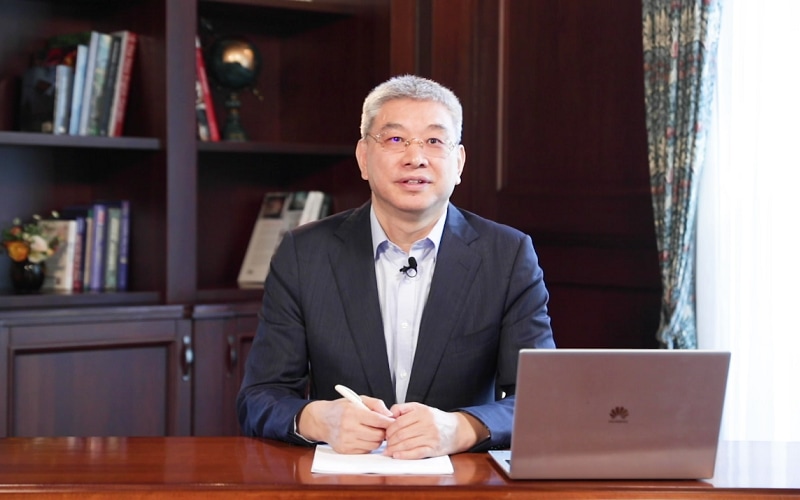Huawei William Xu’s Speech at IEEE Flagship Conference GLOBECOM 2020
[Shenzhen, China, December 17, 2020] At the recent 2020 IEEE Global Communications Conference (IEEE GLOBECOM), upon invitation, William Xu, Huawei Director of the Board and President of the Institute of Strategic Research, delivered a keynote speech entitled The Future of Intelligent Connectivity: Challenges and Directions.
IEEE GLOBECOM is one of the major annual academic conferences organized by the Institute of Electrical and Electronics Engineers (IEEE) to promote comprehensive innovation of communications.
 William Xu, Huawei’s Director of the Board and the President of the Institute of Strategic Research
William Xu, Huawei’s Director of the Board and the President of the Institute of Strategic Research
In his speech, Mr. Xu described 5.5G as “the next step towards realizing our vision for the mobile industry, which is to meet the requirements for the transformation from the Internet of Everything to the Intelligent Internet of Everything.” He also called upon the entire industry to embrace academic diversity and openness and expand the collaboration between industry, academia, and research institutes to jointly promote the development of basic theories and technologies.
5.5G Is the Next Step for the Mobile Industry
The development of 5G depends on investment in the short term, ecosystem in the medium term, and technology evolution in the long term. During 5G’s rapid commercial scale-up, the feedback from both within the industry and from vertical industries promotes the upgrade and expansion of 5G applications to provide more diversified connections with improved quality and “bring the society from the Internet of Everything to the Intelligent Internet of Everything”.
“5.5G is the next step in our vision for the mobile industry,” said Mr. Xu. It is an enhancement and extension of the three standard 5G scenarios defined by the ITU — enhanced Mobile Broadband (eMBB), Massive Machine-Type Communications (mMTC), and ultra-reliable low-latency communication (URLLC). 5.5G will further transcend these three application scenarios with three newly introduced capabilities — Uplink Centric Broadband Communication (UCBC), Real-Time Broadband Communication (RTBC), and Harmonized Communication and Sensing (HCS), going beyond the original three application scenarios to six to meet various industry requirements.
Mr. Xu went on to highlight the three technological requirements to develop 5.5G. “5.5G is originated from 5G and therefore must be compatible with all 5G devices. We must optimize the usage patterns of sub-100 GHz spectrum resources to support on-demand flexible deployment across frequency bands. 5.5G must also be deeply integrated with AI to improve air interfaces, networks, and services while meeting the requirements for diversified networks and energy consumption management.”
Rise to New Challenges and Push the Limitations of Theoretical Frameworks
Driven by strong requirements imposed on AI, connection speeds will increase by 20 times and computing capability by nearly 100 times by 2030. This means enormous challenges for the mobile industry in continuously improving connectivity and computing capability. At the same time, the acceleration of digital transformation across business domains will inevitably lead data centers and networks to scale up significantly, increasing the pressure on the industry to improve energy saving and carbon neutrality.
Mr. Xu also emphasized the urgency and importance of finding new theories and building the mathematical foundations that can break through the theoretical framework to enable more data to be exchanged within limited bandwidth and increase connectivity and computing efficiency. New technologies, such as semantic communications, AI federated learning, and approximate computing, have already shown the society their potential in enabling them to achieve this.
Semantic communications seemed unattainable for more than 70 years until machine learning made it not only a possibility but also an emerging topic of development. If realized, the “Shannon theory” of semantic communications will enable the transfer of a terrific amount of information only with a few bits. AI federated learning enables algorithm training to be widely distributed onto a startling number of nodes to achieve a higher performance, avoiding the transfer of local data to ensure privacy. As the adoption of 5G continues to scale up, the convergence between communications and computing will steadily grow to accelerate the maturity of AI federated learning. Approximate computing offers the industry a new way of balancing power consumption and performance with an approach different from traditional computing. This technology will significantly improve energy efficiency with well-balanced accuracy and approximation.
Academic Diversity and Openness Promote the Development of Basic Theories and Technologies
Connectivity constitutes the cornerstone of the ICT industry, and we can never overestimate the power of connectivity. Now, the society is so dependent on the connectivity that it has already become a necessity in our lives and the fabric of our society. The Intelligent Internet of Everything requires all parties to promote the technological development of 5.5G and other technologies together through collaboration between industry, academia, and research institutes.
Diversity and openness have always been the driving force behind technological progress. We must continue to uphold this idea of openness and diversity to build and share digital ecosystems. Before concluding his speech, Mr. Xu also called on the industry to seize the opportunity of digital transformation and build an intelligent world together.
PR Archives: Latest, By Company, By Date